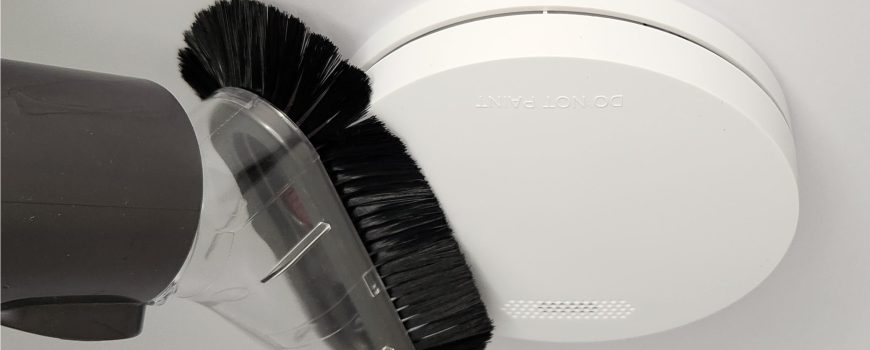Interconnected photoelectric smoke alarms are a crucial safety component of any home – they provide early warning of smoke and fire, giving occupants valuable time to escape. It is important to periodically test and clean all smoke alarms (irrespective of brand), to ensure they function correctly over their full 10-year lifetime. Just as a car is serviced to keep it running smoothly, photoelectric smoke alarms occasionally need some TLC too!
Here are some recommendations on how to test and clean your interconnected photoelectric smoke alarms.
Testing Your Interconnected Photoelectric Smoke Alarms
It is recommended to test ZEN smoke alarms monthly to ensure they are functioning correctly (of course there is nothing stopping you from testing the smoke alarms more frequently if you wish to do so). To avoid surprising the neighbours it is a good idea to notify people in the vicinity that you will be testing the alarms. Once started, the smoke alarm test sequence should take no more than 10-15 seconds and will silence automatically.
To test your smoke alarm(s), follow these simple steps:
- Press the test button once on the optional remote control device or on the smoke alarm itself – the smoke alarm should sound almost immediately. The test button on the ZEN smoke alarm is concealed beneath the surface of the alarm (to give it a slim and stylish appearance). Simply push down once in the centre surface of the alarm to press the test button.
- When the alarm sounds loud and clear and is accompanied by a red flashing light it means your smoke alarm is working correctly and the test is successful.
- If the alarm sounds weak, does not sound at all, or the red light does not flash, you may need to replace the entire smoke alarm. Note the smoke alarm 10-year battery is sealed inside the unit and cannot be replaced as it is non-removable (this is a requirement of Australian Standard 3786:2014). The battery inside the optional remote control device is removeable and replaceable.
- If your ZEN smoke alarm is interconnected with others in a group, ensure they all sound and activate their red flashing light too. Depending how many alarms are in the interconnected group, they should all start within 10 seconds of the first alarm. This is normal.
- Allow the smoke alarms to finish their full test sequence without pressing any other buttons – all the smoke alarms will silence automatically within 10-15 seconds.
It is not recommended to use real smoke, or any other means to test your alarms – doing so can degrade the internal photoelectric sensors, which may induce random nuisance alarming or could even reduce the smoke alarm’s overall life expectancy.
How to clean your ZEN smoke alarms
Cleaning Your Interconnected Photoelectric Smoke Alarms
In addition to testing your smoke alarms periodically, it is also important to clean them every 6 months. Here are some tips on how to clean and maintain your ZEN smoke alarms:
- Over time, dust and debris can accumulate on the sensors of your smoke alarm, reducing its effectiveness. Clean the smoke alarm every 6 months by gently vacuuming around it with the soft brush attachment from a vacuum cleaner, or dusting it with a soft brush. Do not apply solvents or other chemical cleaning agents on or near the smoke alarm itself, as this may confuse the sensor and induce nuisance alarms. Be sure to remove cobwebs or any other interference material from the ceiling area around your smoke alarms.
- All smoke alarms can be affected by extreme humidity and temperature changes. Avoid installing smoke alarms in areas such as kitchens, bathrooms or laundry rooms, where very high humidity or temperature changes can affect their performance. For example, a clothes dryer running in the laundry may increase the humidity in this room, and subsequently trigger a false alarm.
- Do not install smoke alarms outdoors, in partially enclosed areas, or in rooms subject to excess dust i.e. garages or workshops. Heat alarms (complimenting an existing smoke alarm system) may be more suitable for such locations.
- Smoke alarms have a finite lifespan and should be replaced ten years from manufacture date. The low battery beep occurs once every 60 seconds and means it is time to replace the alarm.
Correct Photoelectric Smoke Alarm Placement
It is important that your interconnected photoelectric smoke alarms are installed in the correct locations within your home. It is preferable that smoke alarms are installed on the ceiling – the ‘recommended placement’ section on our website homepage provides further guidance on exactly where smoke alarms should / should not be installed (avoiding ‘dead air’ spaces etc). Smoke alarms that are not installed correctly may be prone to nuisance alarming and/or inhibited performance.
Read the instruction manual and watch the ZEN quick-start video! – the user manual contains helpful troubleshooting tips, outlines best practice for maintaining the alarms, and should definitely be read from cover to cover!
Summary
Interconnected photoelectric smoke alarms are a crucial safety component in any home, providing early warning of smoke and fire. To ensure they function correctly over their full 10-year life cycle, it is important to test and clean them periodically. By following the tips outlined in this article, you will keep your loved ones and household possessions safe and secure from the dangers of smoke and fire. Remember, ZEN interconnected photoelectric smoke alarms are lifesaving appliances – look after them and they will look after you!

Want to know more? Watch our ZEN quick start video or call us on 0478 596 402 today
We love talking smoke alarms!
ZEN Photoelectric Smoke Alarms
New Farm, QLD, 4005

